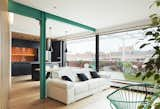Dress Up Your Space With Contrasting Colors
Any room in your home that doesn’t feel quite right could possibly be in need of anything from a shaggy rug replacement to a new sofa. But if you’re really looking to change things up in a way that makes a big impact, consider this: Add some contrast and visual interest with paint—not just one bright color, but two contrasting ones that can add depth to a space and create visual interest without having to (permanently) rearrange any furniture.
But in order to pull this project off without a hitch, there are obvious and not-so-obvious do’s and don’t’s plus a pile of factors to take into consideration. We checked in with Sherwin-Williams Director of Product Excellence Dennis Fiorilli and Color Marketing Manager Emily Kantz for some expert tips on using paint to create contrast.
Why you should use contrasting paint
As a fun door color clearly demonstrates, using paint to create contrast is a straightforward way to whip up some visual interest in an otherwise bland room. "It’s great if you want to draw attention to the beauty of an architectural feature that is typically underappreciated because it has not been highlighted previously," Kantz explains. "For instance, using paint in a unique application such as the inside of an arched opening is a simple but fun way to add a pop of color or contrast to the rest of the room."
Pick your contrasting hotspot
The opportunities for paint contrast are vast—from dark cabinet-to-white wall to white trim-to-neutral wall color and beyond—but each room has a few go-tos for anyone in search of a spot to jumpstart the project.
Kantz suggests using the vanity and the bathroom wall, the entryway and staircases and trims, or kitchen cabinets versus other finishes in the room.
Use what you have
If you’re stuck on what color you want to use and are staring at a color wheel in a mild panic, take a deep breath, and look around for inspiration. "Pull in a color from existing elements throughout the home," Kantz suggests. "If I’m selecting kitchen cabinet colors, I’ll pull a color to contrast with the wall, however it might be a tone within my granite countertop veining. If I’m looking at incorporating a contrasting color for a piece of furniture in my living room, I’ll contrast with the wall color but maybe pull in a shade from a piece of artwork in the room."
Does your taste lean modern and eclectic? Mix paints, textures, and materials like this Laurel Canyon kitchen, which features a range hood made of glazed white tile placed against a graffiti-inspired cork backdrop. If moody’s the mood, pair deep purple walls with eggshell baseboard trims to help the primary paint color stand out further.
Rules of contrast engagement
Dizzying patterns have their place in the realm of interior decor but Kantz emphasizes steering clear of color contrasting combos in small patterns (think fluorescent brights with black or white) that overstimulate the senses. "This can be overwhelming for many people and will not create a very comfortable environment for them," she adds.
Instead, consider incorporating different sheens when adding in contrasting colors to elements throughout the room to keep things more interesting. "For example, using different sheens on a wall with patterns can provide depth. We also see high gloss [commonly] used to showcase furniture or add to an accent wall," adds Fiorelli. Keep in mind, though, that high gloss paints tend to show flaws easily, but they’re easy to clean (among the most durable) and very shiny.
On the flip side, do think of ways to have fun with your contrasting plans. Katz counts the classic black and white color combination as a "fool-proof, classic but never boring" favorite. "The classic contrast between the two turns any space from bland to bold. This works specifically well in spaces like entryways, since you can add a touch of a true-black such as Tricorn Black SW 6258 on trims or staircases," she adds.
Start small and use quality tools
Once you’ve settled on the elements, paint colors (to sheen or not to sheen), and the location, focus on the fun. Also, if you’re not sure where to start, stick to a small plan like a simple accent wall that contrasts a large piece of furniture. Fiorelli’s final tip? Use good tools.
"From the types of brush and roller, make sure it is the best for that paint and sheen to allow you to get the best finish."
Top image originally found in A Childhood Home in Madrid Grows Up
Published
Topics
RenovationsGet the Dwell Newsletter
Be the first to see our latest home tours, design news, and more.





